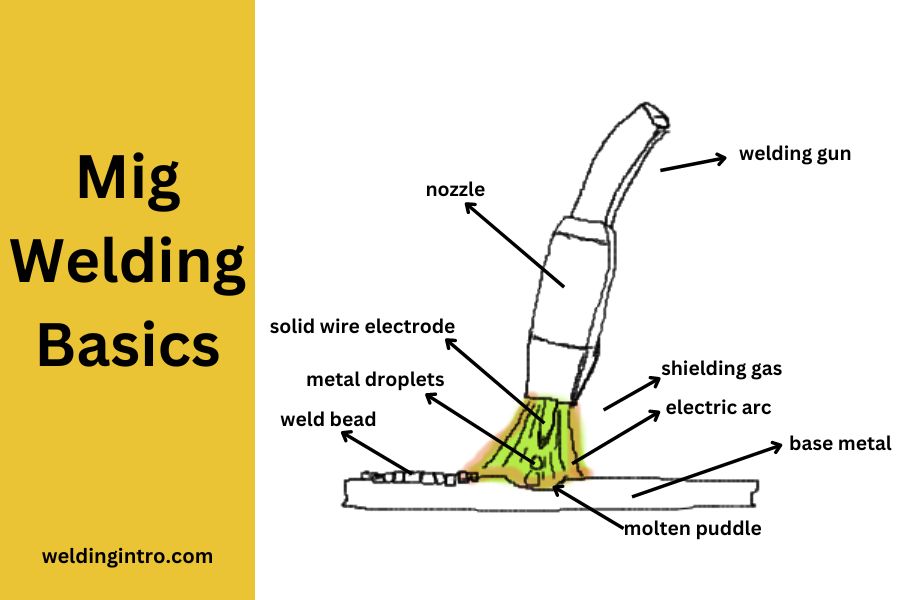As a beginner, it can be overwhelming to start learning about welding, especially MIG welding. MIG (Metal Inert Gas) welding is a popular type of welding that is commonly used in industrial and DIY projects.
In this article, we will provide a comprehensive guide to MIG welding for beginners.
What is MIG Welding (Described for Beginners)?
Mig is a welding process widely used by fabricators all over the world. It is commonly used for its easy to apply attribute and also for its efficient high quality weld bead over the metal.
Mig welding is using a spool of electrode wire that is continuously fed in a wire feeder through a mig welder gun to join two metals. Here the wire is melted (by heating it with an electric power source) to join the pieces of metal.

Mig is a speedy process and easy to use technique. That’s why it was invented in the era of the second world war while scientists were researching to improve SMAW technique. Invention of Mig welding enabled the welders to weld in a short time with high efficiency.
From its invention, it has been continuously improved and now new technology has brought about modern Mig variation like STT welding mode that increased productivity & overall weal quality at a time. GMAW is a very flexible technique & ensures best weld quality over a wide base material type and any metal thickness.
How Mig Process Works
As a beginner one must know how mig welding functions. It is necessary to learn the basics. It will help to improvise the application over various materials as different projects require different approaches. So lets know the basic of how it works-
We already know that Gas Metal Arc Welding (GMAW) is a popular welding process that uses a solid wire electrode that is continuously fed as the filler metal. The molten pool and heat affected area over the base metal melts to join the metals together. Here gas is released from the gas tank which protects the weld from external environmental contamination.
The wire being used in mig welding needs to be chosen correctly. The correct wire depends on the metal being welded. It should match the base and work metal. For example- alloy and steel wire are very compatible with any metal and create a glass like coating over the welded area. It is because this type of wire usually contains a copper layer to protect it from rust.
The best welding results depend on good technique. Mig is both a good technique and an easy one. If operators use expertise and weld properly then mig welding cannot be replaced by any other welding techniques in case of quality. Properly finished mig weld is free of slags and in turn free from spatter. You need to keep the work and base metal clean of rust and dirt before starting and after finishing the weld.
Grinding is necessary after finishing the welding. Grind lightly until the bare shiny metal appears.
Gmaw process normally runs in dc current flow. Its electrode faces the positive terminal DCEP (called reverse polarity in the USA).
Properly Mig welding metal will have a glass coated clear bead over the welded area. It can be easily removed. You are able to change the mode, amperage of electricity, transfer mode, travel speed, voltage and wire feed rate as required for specific operation. That’s why mig is a flexible technique.
You can control the deposition rate in mig welding also. You can do so by changing the transfer mode in your mig welder. There are 4 types of transfer mode in the welding process.
They are
- Short circuiting transfer mode
- Globular transfer mode
- Spray Transfer mode
- Pulsed Spray Transfer Mode
I have covered different transfer modes in a separate article. Check it out now.
Components Necessary For Mig
We have learnt about mig welding and how it works. Now it’s time to introduce the components you need to learn in Mig welding.
In any welding process you need to know about electric arcs. Especially in mig you need to learn about arc because there are a number of options and variants that play with each other components to achieve the ultimate goal of welding. Following are the components in mig welding-
- Parameter-voltage , current
- Type & size (diameter) of electrode or wire
- All physical forces like – gravity, surface tension, electromagnetic force
- Base metal
- Cleanliness of base and work metal
- Lastly, shielding gas
What Metals Are Suitable For Mig Welding
Mig welding is suitable to weld any metal in the world. It is mostly suitable to work with
- Aluminum
- stainless steel
- carbon steel
- alloys of aluminum
- copper
- chromium
- and low alloy steel.
To weld different types of metal you need to adjust the mig welder settings set to different configurations. For example you may need to increase or decrease travel speed, wire feed speed, current flow for getting better results. You may need to pose different movements and weld in different positions for better welding.
Though you can weld any metal with a mig welder, you need to take precautions and safety measures before starting the process.
Getting Started with MIG Welding (Preparation)
1. Prepare Machine
First step is to prepare the mig welder. The setup is very easy if your machine wire feeder is inbuilt in the power source. You just need to connect the main plug to one phase or three phase circuit to power up the machine.
Modern mig welders have an inbuilt feeder with a power source so don’t worry about the connection there. The shielding gas is connected to the wire feeder. You just need to plug the cable of the gas meter to the welder’s gas point.
2. Safety gears
Make sure you get all the safety gears with you. Safety gears contains
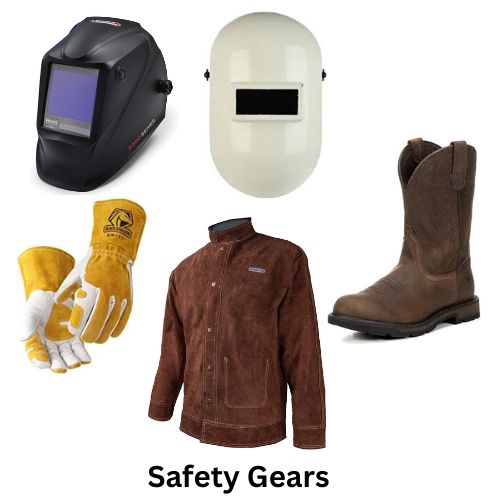
- Helmet or welding hood (most important to protect your eyes from weld arc)
- Welding boots
- Welding pants
- Welding cloths
- Gloves
- A fire extinguisher
- Quite and clean environment
All the necessary safety equipment will help you process your welding safely and properly. People think that safety equipment is only for security from accidents. But they not only provide safety, also energize you and help in perfect results.
So keep the equipment ready before we start welding.
3. Base metal
Base metal is the metal with which you are trying to join the work metal. For example if you want to join a stainless steel rod to an aluminum plate in a vertical position, then the aluminum plate is the base metal and the steel rod is the work metal.
You will need to select the correct wire in case of welding different metals. If the base metals are similar, then copper wire is enough to weld the metals.
Prepare the metal and remove dust, rust or paints from the base. It will help to perfectly weld the work metal to bas metal.
4. Environment
Environment of the welding area should be clean and calm. And most importantly the environment should be well-ventilated and free of flammable materials. Environment plays an important role in proper mig welding. It helps you to concentrate on the work.
Also the environment is necessary to make the weld free from contamination. Contaminated air results in a bad weld pool over the base metal and ruins the work.
5. Gas tank
Gas is a necessary element in mig welding. Gas tank is the bottle where gas for mig welding is stored. Basically 3 types of gas are used in mig. Argon, Co2 and mix of argon & co2 gas. Each gas type has a different impact on welding results.
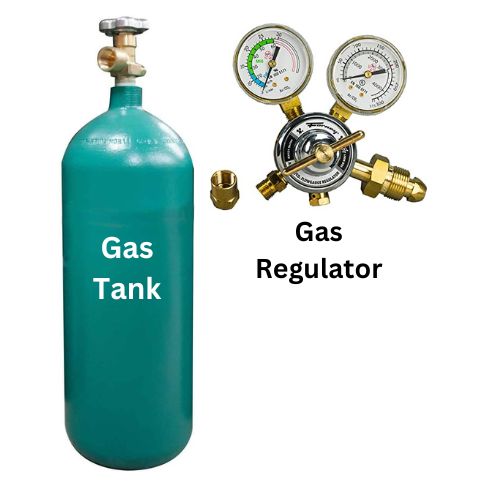
To get better results, the right gas flow rate is important. For that purpose a gas regulator is connected to the gas tank. You must regulate the gas flow for better quality.
Why is gas flow regulation important? I have covered the topic in different articles. Check that out if you want to learn more.
Gas meter provides 2 important readings to the welder 1) is from an internal cylinder that provides measures of how much gas remains in the bottle. And 2) the measure of gas that exerts from the cylinder. Rate of gas flow is measured in CFH (cubic feet per hour).
6. Cable
Cables are responsible for carrying current machines to the welding work area. This cable is called lead. This lead is connected to the torch of the mig welder. There is another cable that connects the work area or base metal with a ground clamp.

It is for earthing. The cable must be well protected and free of damage. As it carries high voltage current so it is dangerous to have any damage on the cable. The cable is well protected with rubber covering and the main cable is usually made of copper.
7. Torch
Prepare the torch and configure it well for mig welding. In the torch there are mig gun contact tips, Teflon liners (inside-outside), gas diffuser and nozzle. Torch can be air cooled or water cooled in feature.

It works as a conduit for current, shielding gas and the electrode. Wire runs through the torch and connects in the contact tip. The contact tip is the area which gets in touch with the metal and creates an arc. Before starting mig welding, learn how to hold and move torches in different positions for better weld.
I have a separate article on mig torch. Check it out also.
8. Wire selection
One of the most important jobs in mig welding is wire selection. As a beginner one must learn how to select mig wire for different projects and various metals.

Mig wire connects the wire feeder (in power source) to the torch. It normally remains in a spool hung inside the machine. Wire selection depends on the metal thickness and type of metal. Below is the list of wire sizes for mild and carbon steel welding.
| Diameter | Metal Thickness |
| 0.023 inch | Good for thin sheet metal. Normally for 24 or around 16 gauge |
| 0.03 inch | Good for 1/8 inch thick sheet metal |
| 0.035 inch | Good for up to ¼ inch thick metal metal. This one is best for beginners. |
| 0.045 inch | Best for ¼ inch thick metal and metal thicker than that. |
I have covered how to install wire in the cabinet in a separate article. Also check that.
MIG Welding Techniques for Beginners (Steps)
As a beginner, there are a few key techniques you should practice to improve your MIG welding skills. They are-
- One of the most important techniques is maintaining a consistent travel speed. This means moving the welding gun at a steady pace to ensure an even weld bead.
- Another important technique is maintaining a consistent arc length. This refers to the distance between the welding gun and the metal you are welding. Keeping the arc length consistent will help ensure a strong and consistent weld.
- Finally, you should practice good technique when starting and finishing your weld. This involves gradually increasing and decreasing the wire feed speed to create a smooth start and finish to your weld.
Common Problem In Mig Welding
As a beginner you must know some common problems associated with mig welding. Most of the time you will encounter these problems if you are not aware of them. The problems can ruin your work and even damage the welder.
- Porosity: When you are welding, the environmental elements may react to the molten weld pool. It traps the gas and makes holes on the weld once the metal becomes cold. Another name of porosity is swiss cheese. The name justifies its appearance.
- Cracks: You may encounter cracks after you finish your weld. The reason for the cracks may be for choosing the wrong gas, not giving enough time to cool down the weld after one phase of weld or not filling the joints properly. Cracks are common problems that every welder faces in their early welding career.
- Undercut: It is basically grooves over the base metal after welding. It occurs for applying the wrong welding technique. It leaves so much wide un-welded area that you can’t fill that with filler material.
- Distortion: We know that metal expands or contracts because of heating. So when metal cannot cope with the expansion of heating or cooling, then distortion occurs. It is also called warping.
- Burn through: Burn through is a common welding defect that can occur during the MIG welding process. It refers to a situation where the welder melts the base metal, creating a hole or gap in the weld area. Burn through can be caused by various factors, such as using too much heat, using a welding wire that is too thin or using the wrong welding technique. If left unaddressed, burn through can compromise the structural integrity of the weld, leading to possible failure under stress.
- Spatter: Spatter is a common issue in welding, which refers to the metal droplets that are expelled from the welding arc and adhere to the surrounding surfaces. Spatter can be caused by several factors such as high welding current, incorrect gas flow, improper welding technique or using the wrong type of wire. The spatter can cause problems in the final welding finish and can also affect the overall performance of the weld.
10 Tips For Beginners In Mig
- Safety first – always wear appropriate personal protective equipment (PPE), such as a welding helmet, gloves, and safety glasses.
- Wire: Use the right welding wire for the material you are welding.
- Settings: Adjust the welding machine settings based on the thickness of the material being welded.
- Cleanliness: Keep the workpiece Clean before welding to ensure a clean and smooth weld.
- Welding gun: Keep the welding gun at a consistent distance from the workpiece to avoid spatter and achieve a clean weld.
- Correct Travel angle: Use the correct angle and technique when welding to ensure the weld penetrates the material fully. Start with push at 5° to 15° angle toward the weld progression to enhance gas coverage and clear weld.
- Practice: Practice on scrap metal before welding on your project to gain experience and improve your technique.
- Gas: Use a shielding gas appropriate for the type of material you are welding to ensure a quality weld.
- Ventilation: Ensure proper ventilation in your workspace to prevent harmful fumes from accumulating.
- Maintenance: Regularly maintain your welding equipment, including cleaning the gun and replacing worn-out parts, to ensure consistent performance and extend the equipment’s lifespan.
Books Recommended for beginners
If you are a good reader and want to learn in detail about mig welding also if you want to become a certified mig welder, there is no alternative to books. Fortunately there are a bunch of books that cover every area of welding technique. You may find them at your local library. You can find them online too.
I have listed some books below that will walk you through mig welding as well as other welding techniques in detail. You will find them all in amazon.com.
1. Welding For Dummies
The book is written by Steven Robert Farnsworth. The writer has described different type of welding (mig, tig, stick, flux core and oxy-fuel cutting techniques in this book. He also provided some practical advice on different welding processes.

You will learn how to get welding training certification and also will learn about modern technology in welding like laser technique here. This book is written keeping beginners in mind.
So you will have no hard time understanding the lessons. This book is really for a dummies book of welding. The book has 384 pages and will cost you only $17.89.
What it covers:
- Choosing right metal best equipment’s
- Using best technique in welding
- Tips in preparing workshop
- Safety requirements and reducing potential injury
- Great project ideas and repairing techniques
- Gorgeous finishing
2. Learn to Weld: Beginning mig welding and fabrication
This one is a beginner friendly book written by Stephen Christena. This one covers MiG welding in detail and also covers some important aspects of metal fabrication work for home diy welders.
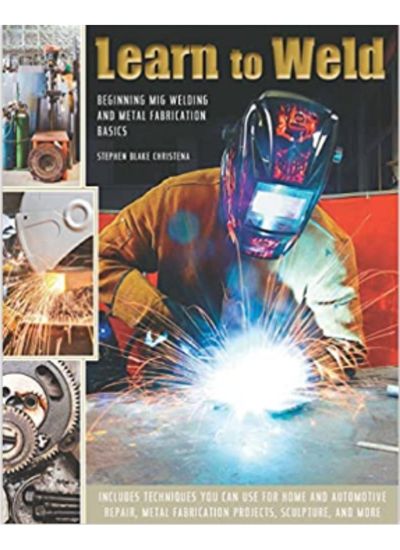
You will learn how to set up a shop or studio for welding projects, equipment and material necessary for welding projects and fabrication work with a step by step guide.
Good thing about the book, the author has described every technique with photos and tutorials. The book contains
- How to cut and grind the metal
- How to troubleshoot problems and quick solution in mig welding
- Small courses to teach basics to newbies
- How to efficiently mig weld any metal
- Making sculpture and other designs with mig welding
The book has 176 pages and costs only $14.99.
Check it out now
3. Farm and Workshop Welding,3rd edition
This one’s for professional welders who are looking to establish a workshop and farm. The book is written by Andrew Pearce. The author has shown how you can repair metal equipment & structures.

He described the different welding process and techniques, common mistakes in welding and how to fix them. The book also shows how to avoid mistakes in welding and suggested some tips for beginners and professionals.
The book includes-
- 400 step by step photos describing the welding techniques and good weld
- How to weld on cast iron, pipe and hard fence
- Blacksmith Techniques (basic)
- Metallurgy and plastic welding technique
- Soldering
- Safety
- Taps & dies
- Workshop welding
And so on. It is 192 pages long and costs only $22.49.
Check it out now
4. Audel Welding Pocket Reference
The book is written by James E. Brumbaugh. This pocket size reference welding book provides information on different welding projects, common problems welders face and the solution to the problems, symbols and charts that welders come across regularly, different joints and requirements in welding.
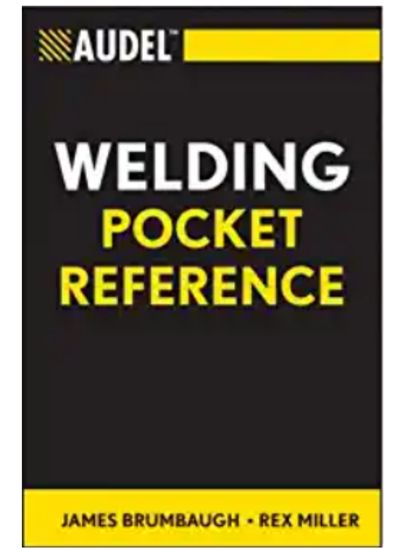
This book covers
- Review of metal cutting and information on protective gears
- Instruction on welding alloy, cast iron and other metal
- Welding techniques, brazing
- Tips to proper welding
- And a guide to choosing the right electrodes.
It costs only $17.47 and have 448 pages.
Check it now
5. How To Weld (Motor books Workshop)
This one is written by Todd Bridigum, a AWS certified welding instructor. The book is all in one welding book for beginners and also for professionals. If you want to have in- depth knowledge in welding ,then this book is best for you.
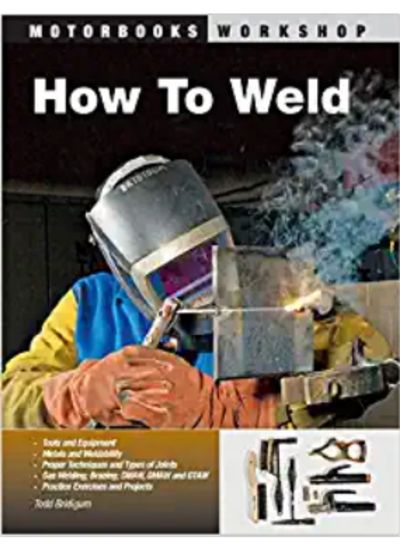
The book covers
- Introduction to tools and equipment’s that are used by welders regularly
- It lists the metals that can be welded
- It covers all welding techniques (mig, tig, stick, flux core, and other)
- It provides information on how to be safe in welding and maintain safety in workshop
- All types of joints
- Beautifully crafted photos and illustration to make you understand the welding basic
- Guides to diyers, mechanics, automotive enthusiasts, metalworkers and newbies to learn and master welding
The book costs $13.07 and has 208 pages.
6. How To Weld For Beginners
Dillan Powell is the writer of this book
If you are looking for amazing DIY pieces for home or commercial purposes and a guide that will answer all the questions about welding, then you need to check the piece out. This book describes welding in an instructional way and step by step. This one is a beginner-friendly book.
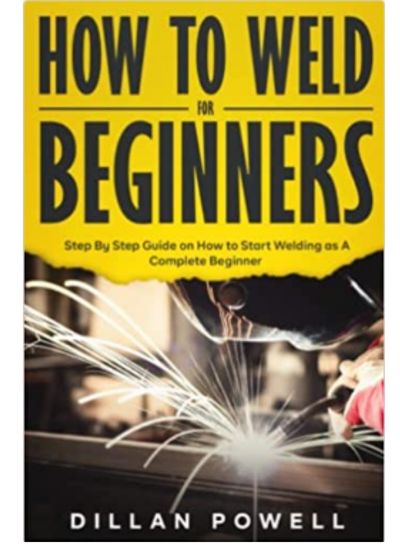
It covers
- Comprehensive guide to beginners about welding process and techniques
- Basics to professional level welding techniques
- Essential tools and introduction to them
- How to heat, cool and solidify the metal in welding
- What metals to use and what welder to use in what situation
- All safety equipment like helmet, gloves, goggles and also accessories like pliers, clamps and wire cutters.
- How to choose correct electrodes and gas for welding
- Best practices in welding
This one costs only $12.99 and has 119 pages.
Check it out
FAQs about MIG Welding for Beginners
Q: What is the difference between flux core and MIG welding?
Flux core welding uses a wire with a flux coating that melts and protects the weld from contamination, while MIG welding uses shielding gas to protect the weld. This is the core difference between mig and flux core welding.
Q: Do I need to use shielding gas when MIG welding?
Yes, shielding gas is essential for MIG welding to protect the weld from contamination and ensure a strong bond between the two pieces of metal.
Can I weld without gas?
Yes, it is possible. When you use flux cored electrodes in mig welding, then there is no need for external gas.
Lastly
Welding is an essential skill that metal workers need to master. Mig welding is most remarkable one in welding techniques. Learning mig welding and applying the skill in real life work is easier than you think.
You just need to make an attempt to learn the process and after that you may master it by continuous practice. For beginners welder mig welding is the most recommended technique to start with.
Sources

